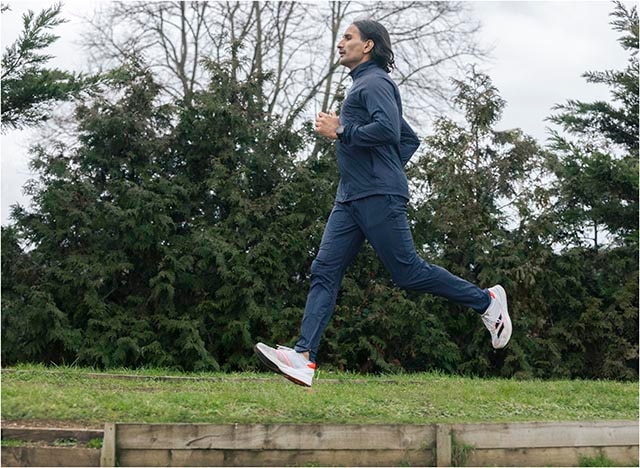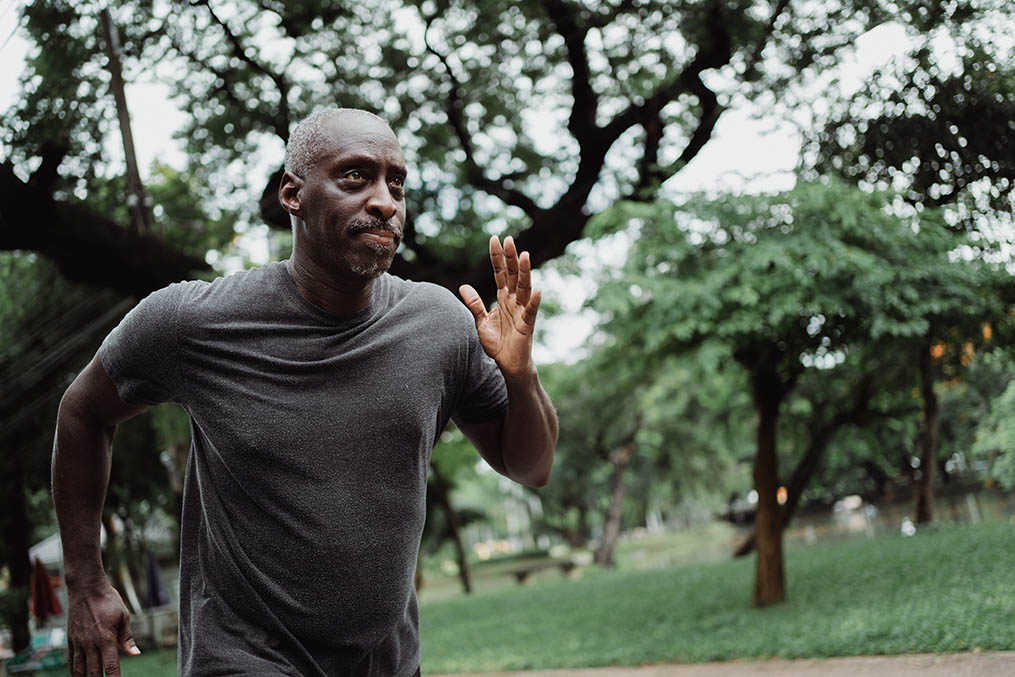The ultimate guide to winter training
Let’s face it … training through winter can be challenging for many reasons!
Of course, the weather is a big factor here, there’s less daylight hours so you may need to train in the dark, which can be hard in itself, but then if you add in the cold, wind, and rain, it really tests your motivation. You also need to factor in staying safe, especially when there’s a really cold wind or if there’s ice and snow, which can make under-foot conditions hazardous, and ensuring you’re visible when out on the roads.
The key thing to keep in mind is to try to maintain consistent training while staying safe. On bad weather days simply train at a more controlled and comfortable effort or, if in doubt, head to the gym for a class or to use the machines and stick with the treadmill for any faster paced runs.

So, it’s important to think about:
-
Wearing appropriate clothing
-
Good traction on your running shoes
-
Trying to train in the day time
-
Reflective strips on kit and shoes for good visibility; be visible, be safe
-
Alternative training options
Having the right kit is vital for a runner. It helps you look the part (which makes you feel better and more positive about your running), but it'll allow you to move more efficiently, be more comfortable on your run but importantly to be visible and stay safe.
Try to be efficient with the kit you buy and wear; don’t be the runner who heads out the door wearing too much clothing and ends up overheating and having to tie their jacket and long-sleeve top around their waist! It's unnecessary, with the development of technical sports fabrics, there’s no reason to end up carrying extra weight and wind resistance!
Think about how you'll be dressed for the end of your run, and dress accordingly to that. If you’re going for an easy run, then you won’t be working so hard and can get away with an extra layer, but if you’re doing a threhsold session, you’re going to sweat, so a thin layer or two should work perfectly. Think about how long you’re going to be outside - if it’s a long slow run, but windy, then tights might be better than shorts to cut some of that wind-chill down.
Make sure you have a good quality jacket; there are plenty out there to choose from, but it’s worth spending a bit extra if you can on a quality jacket that will last a few years. There are Gore-Tex waterproof jackets, but these do keep the heat in, so you can end up sweating so much it was almost pointless! Windstopper jackets will keep the wind out, but after a while will let a bit of water in (but a bit of rain never hurt!) Brightly coloured jackets are useful, as they'll keep you seen! Or if you find jackets might make you too hot, perhaps consider wearing a gilet instead.
Running tights keep your legs warm, but allow for a full range of motion in your legs, so you can actually run! Tights come in a variety of thickness and lengths, so it’s a personal preference for what you want. Ideally, having a few different pairs would be helpful so you can pick the thickness depending on the type of run you’re doing.
Layers work well - some moisture-wicking, thin layers work really well in the winter and you might consider having a short sleeve t-shirt with a longer-sleeve tee over the top, to keep you warm without wearing too much.
Whatever you choose as your outer layer, make sure that it’s a bright colour with reflective strips or wear a runner night-time fluorescent tabard…. stay safe, be visible!
And don’t forget your hat & gloves, so important for keeping the chill off your extremities, while also allowing you to regulate your temperature just by taking them off and putting them in a pocket if you do get a bit warm.
Make sure that you have shoes with good traction however if it’s icy, even in patches, then it’s smart to switch to running indoors on the treadmill or swap to a cross training or a conditioning session, it’s much better to be safe rather than risk falling over, twisting an ankle or injuring your knees, resulting in a long-term injury. It’s smarter to move your training plan around and wait until the weather improves.
Having the right kit is important for smart training, but so is having the right nutrition and hydration. You need to fuel your engine correctly so that you not only have the energy for your training but also for recovery. It’s also important that you hydrate correctly; it’s easy to think that just because it’s cold we don’t need to drink water, but we do! Good hydration is the key to our body working efficiently and feeling good.
The other key aspect of training in the winter is the effect it has on our motivation; nobody likes training in the dark, cold, and wet and it’s quite normal to question why on earth we’re training, but it’s how we deal with this that’s important.
So, focus on your goal and remind yourself why you’re putting in the hard work, what are you training for and why did you set yourself the challenge in the first place, why is it important for you to achieve that goal? An added incentive is to remind yourself of the importance of training through the winter months, it’s when you’ll be building a good base of fitness to take you into the spring, so that you’re in excellent condition and ready for your challenge.
You hear people talking about “mental toughness” or when you’re running a race somebody shouting at you to “dig in” or “dig deep”, well we can’t just turn on a tap and suddenly and miraculously be ‘mentally tough’. In fact, mental toughness comes from experiences and from your focus and desire to achieve your goals. It comes from having finished tough training sessions in challenging conditions. It comes from you committing to your training plan, being resilient and consistent to stay true to your goals in the face of external pressures.
Experiencing and rising to the challenge when training can often be uncomfortable, but it will boost your confidence and this gives you the self-belief that you can get through any challenging situations, in life and in your training. This improved resilience and mental toughness helps to make things seem easier. As you get tougher, you expose yourself to more disagreeable situations, your mental toughness and resilience becomes ingrained and can be called upon in any challenging situation, which particularly will be beneficial in the final miles of the marathon or other running events.
So, get the right kit, keep a focus on good nutrition and hydration, experience the highs and lows of training through winter with a solid mental approach and a smile on your face and you’ll not only learn a lot about yourself, but you’ll have a positive enriching experience on the journey to your goal.
Keith Anderson
Head Coach
Full Potential Coaching

Optimising Hydration for Interval Training
Discover the world of Interval Training. Learn practical tips to stay hydrated, fight fatigue, and regulate your body temperature thanks to proper hydration.
Take a look
Our 2024 Rise Up Runners
Witness the journeys of our three BUXTON Rise Up Runners and see the positive impact that running and training for the 20234 TCS London Marathon had on their mental well-being.
Take a look
Marathon Training: The good, the bad and the ugly
Explore the highs and lows of marathon training with Buxton. Learn about smart training plans, maintaining consistency, and managing physical and mental challenges.
Take a look
The ultimate guide to winter training
Let’s face it … training through winter can be challenging for many reasons!
Take a look
BUXTON Sweat and Tears Runners Share Their Post-marathon Feelings
And just like that, the London Marathon 2023 has come to a close! After experiencing that rush of adrenaline when they crossed the finish line, we asked our Buxton Sweat and Tears Runners to share their post-marathon feelings and any other reflections they had after completing this huge achievement. See what wisdom they had to share below.
Take a look
3 Rise Up Marathon Runners Tell Us About Running and Mental Health
3 Buxton marathon runners share with us how running and training for the marathon helped with their mental health. See their inspiring stories here.
Take a look
The Mental Benefits of Exercise
We already know that exercise is good for us but it can also help improve our mood, help with anxiety, stress and depression and also improve our sleep patterns.
Take a look
The Benefits of Cross Training
Cross training really just means incorporating a number of different activities into your exercise routine. By doing this you’ll use a range of movements and load a variety of muscles, bones, joints, and ligaments which in turn will help avoid the repetition or impact injuries associated with a single activity, such as running.
Take a look
Getting started and preparing your body and mind for training
“The miracle isn’t that I finished. The miracle is that I had the courage to start.” ~ John Bingham
Take a look